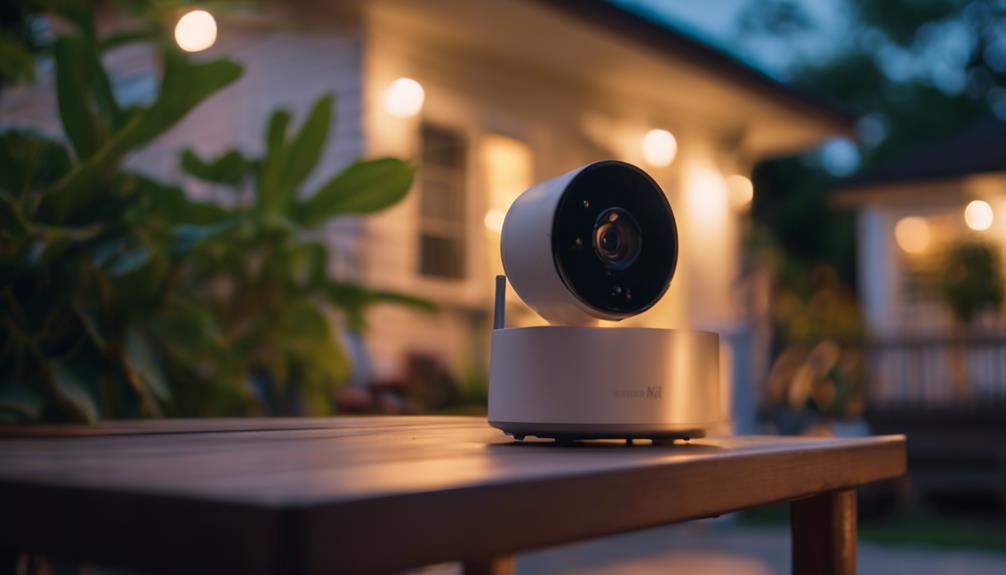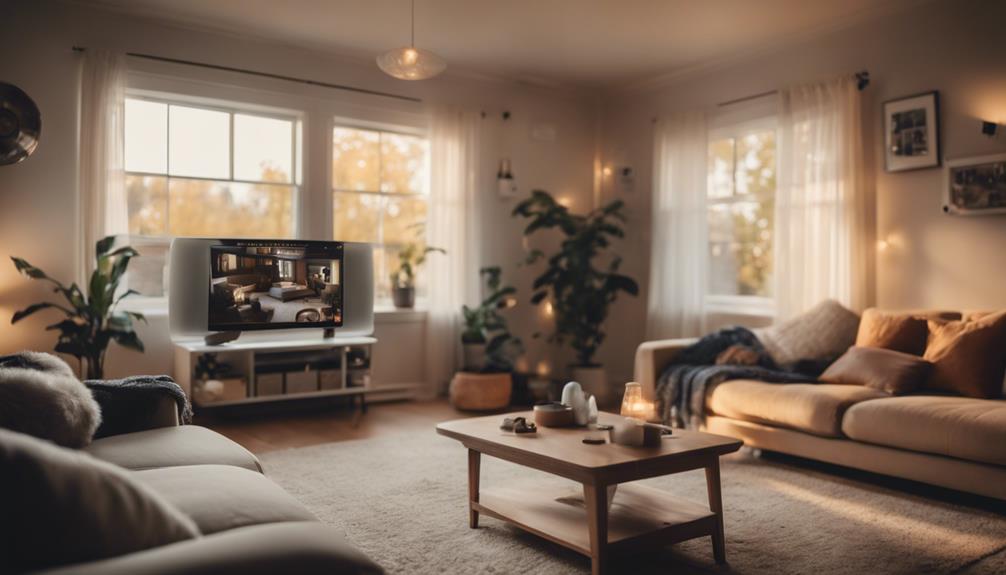Choosing the appropriate home security system begins with identifying your specific needs. Assess vulnerable areas such as entry points and decide how you would prefer the system to be set up – professionally or as a do-it-yourself project. Then, establish a budget that encompasses equipment, installation, and monthly monitoring expenses. Investigate different monitoring options, including professional and self-monitoring, to determine what works best for you. Make sure to also consider crucial features like cameras and smart home compatibility. By taking these factors into account, you can make a well-informed decision that effectively secures your home. There is even more to discover to ensure you select the optimal option for your circumstances.
Key Takeaways
- Assess your home's vulnerable areas and unique security needs to determine the right system features and equipment.
- Set a realistic budget, including installation fees and potential monthly monitoring costs, to guide your choices.
- Decide between professional installation, DIY, or a hybrid approach based on your comfort level and expertise.
- Evaluate monitoring options, considering the trade-offs between professional assistance and self-monitoring for emergencies.
Assessing Your Security Needs
To effectively evaluate your security needs, start by identifying vulnerable areas around your home that could be targeted by intruders. Focus on back doors and first-floor windows, as these spots are often easy access points.
Additionally, consider enhancing your security with modern garage door openers that offer advanced features like smartphone connectivity and security alerts.
Next, consider your lifestyle factors. If you live in an apartment, a DIY installation might be sufficient. However, larger homes may benefit from professional installation to guarantee thorough coverage.
Examine specific security concerns unique to your environment. For instance, sliding doors may require additional protection, such as glass-break sensors, while environmental monitoring can alert you to smoke or carbon monoxide issues.
Research various home security systems, including monitored and unmonitored options, to find what aligns with your comfort level regarding ongoing monitoring and emergency response.
Keep in mind the initial equipment costs and installation fees, which can range considerably. You'll also want to factor in potential monthly monitoring costs that can add to your budget.
Budgeting for Your System

Setting a realistic budget for your home security system is essential to assure you choose a solution that meets your needs without breaking the bank.
Start by determining how much you can comfortably spend on base packages, which can range from $139.99 to over $599.99. Don't forget to factor in installation fees, which typically add $49 to $249.99 to the overall cost.
Deciding between DIY installation or professional services can greatly impact your budget, as it may require different trusted payment solutions for your transactions. Monthly monitoring costs can vary widely, from $5 to $65+, so explore providers that fit your financial plan. Some, like Ring Alarm and Abode, offer options with no monthly fees for added budgeting flexibility.
Be cautious of contracts for professional monitoring that can last up to three years—hidden fees may lurk in the fine print, so review terms carefully.
If your budget is tight, consider financing options, such as 60-month interest-free plans, to help manage costs while securing your home.
Installation Options

When it comes to installing your home security system, you've got a few choices.
You can opt for professional installation for expert setup, tackle it yourself for cost savings, or even choose a hybrid approach. Each option has its own benefits and costs, so let's explore what works best for you.
Additionally, when selecting a service, it's beneficial to check for certifications and insurance to guarantee reliability.
This can provide peace of mind, knowing your installation is handled by qualified professionals.
Professional Installation Benefits
Opting for professional installation not only guarantees ideal equipment placement but also greatly reduces the risk of errors that often accompany DIY setups. With experts handling the installation, you can expect enhanced effectiveness from your security system, as they know how to optimize each component based on your home's layout. Additionally, their experience in innovative design and functionality assures that your security system isn't only effective but also seamlessly integrated into your home environment.
Furthermore, professional installers conduct a thorough assessment of your property, identifying vulnerable areas that might need extra attention or additional sensors. This proactive approach assures that your security system covers all potential threats, providing you with peace of mind.
Many services also offer warranties on both the equipment and installation work, protecting you against potential issues down the line. If something goes wrong, you won't have to worry about footing the bill for repairs or replacements.
Moreover, flexible scheduling options make it easy to arrange an installation that fits your availability, eliminating the stress often associated with DIY setups. By choosing professional installation, you invest not just in a security system, but in a wide-ranging solution that prioritizes your safety and convenience.
DIY Installation Advantages
DIY home security systems offer a straightforward and cost-effective way to secure your property without the need for professional installation. With their pre-programmed features, you can enjoy quick installation, often completed in just a few hours, providing you with immediate peace of mind.
Here's a quick overview of the advantages of DIY systems:
| Feature | Benefits | Ideal For |
|---|---|---|
| Quick Installation | Set up in hours | Busy homeowners |
| Budget-Friendly | No installation fees | Cost-conscious buyers |
| Flexibility | Easily relocate/setup | Renters or frequent movers |
| Customizable Features | Tailor to your security needs | Tech-savvy users |
| Control Over Configuration | Address specific vulnerabilities | Homeowners seeking control |
These systems empower you to customize features according to your unique security needs. Plus, their flexibility allows you to adjust your setup as life changes. Whether you're protecting against specific vulnerabilities or simply want a reliable security solution, DIY home security systems provide the tools you need, making them an attractive option for anyone looking to safeguard their home.
Installation Cost Comparison
Evaluating installation costs is vital in deciding between professional and DIY home security systems. Professional installation typically incurs fees ranging from $99 to $249.99, depending on the complexity of the system.
If you opt for DIY security systems, you can save on installation costs and enjoy flexibility in placement. These systems often come pre-programmed, allowing you to set them up yourself within a few hours, making them an affordable option for renters or smaller homes. Additionally, having a methodical approach to setting up your security can guarantee that all components are ideally placed for maximum coverage and effectiveness in detecting intrusions. This aligns with best practices in software quality assurance, where systematic evaluation is essential.
Choosing a DIY option means you'll eliminate ongoing professional monitoring fees, but it might require a bit more tech-savviness for effective setup and operation.
If you prefer a middle ground, consider hybrid options. These allow for professional installation of certain components while giving you the freedom to manage other installations independently. This approach combines the benefits of professional guidance with homeowner management, catering to your specific needs.
Ultimately, evaluating your comfort with technology and the complexity of the system will help you choose the best installation option. Whether you go for professional installation, DIY security systems, or a hybrid approach, it's vital to weigh the costs against the advantages each option offers.
Monitoring Services

When it comes to home security, choosing between professional monitoring services and self-monitoring options can greatly impact your peace of mind and budget. Professional monitoring offers 24/7 surveillance and immediate emergency response, which can be vital for homeowners worried about security threats.
Additionally, implementing smart home devices can further enhance your security system, providing features such as remote access and alerts for unusual activities. However, this convenience comes with monthly fees that can range from $5 to $65+.
Here are three factors to evaluate when deciding:
- Response Time: Professional monitoring guarantees quick emergency response, while self-monitoring systems rely on you to act.
- Cost Efficiency: Self-monitoring systems often have no monthly fees, making them budget-friendly, but lack professional intervention.
- Advanced Features: Some monitoring services include video verification, allowing agents to see and communicate with intruders in real-time, enhancing response effectiveness.
Ultimately, the choice between monitoring services will hinge on how much you value peace of mind and your willingness to pay for added security. If you prefer direct control without monthly fees, self-monitoring may fit your needs. However, if you want all-encompassing protection, professional monitoring might be worth the investment.
Evaluating Features and Equipment

Prioritize essential components like entry sensors, motion detectors, and security cameras to guarantee your home is effectively protected. These elements form the backbone of any reliable security system.
Look for customizable packages, allowing you to tailor the equipment to your specific needs, ensuring thorough coverage of vulnerable areas in your home. Additionally, consider integrating air purification systems to enhance indoor air quality, as a healthy home environment contributes to overall safety and well-being.
Consider systems that support smart home integration. This feature enables you to control your security devices remotely using smartphone apps, adding convenience and enhancing your overall security.
Evaluate additional features like glass-break sensors, which can alert you to potential intrusions, and environmental monitoring to detect hazards such as smoke or water leaks.
It's also vital to check the compatibility of your chosen security system with existing smart home devices. Effective integration can streamline your home security setup, allowing for seamless operation and remote control of all your devices.
Researching Providers

When you research home security providers, it's essential to compare features and prices to find the best fit for your needs.
Consider looking into the importance of payment data protection as you evaluate different systems, especially if you plan to integrate smart home technology that processes personal information.
Look closely at installation options and what each provider offers, as these can greatly impact your overall experience.
Compare Features and Prices
Comparing features and prices of home security systems helps you find the best fit for your needs and budget. Start by evaluating the essential components that will enhance your home security. Focus on:
- Essential Features: Look for entry sensors, motion detectors, and video monitoring to maximize your home's protection.
- Pricing Structure: Base packages can range from $139.99 to $599.99+, with installation costs typically between $49 and $249.99.
- Monthly Monitoring Fees: Some providers, like Ring Alarm, offer no monthly fees, while others, such as ADT, start at $45.99 for professional monitoring.
As you compare features, keep an eye on customizable plans that cater to your unique security needs.
Don't forget to check customer reviews for various providers to gauge their service quality. Resources like U.S. News can help you with thorough comparisons, ensuring you make an informed decision.
Additionally, consider potential long-term savings on insurance premiums with a monitored security system. This approach will help you align your choice with your budget and enhance your home's safety.
Evaluate Installation Options
How do you choose between DIY and professional installation options for your home security system? Start by considering your needs and preferences. DIY systems like Ring Alarm and SimpliSafe offer flexibility and quick setup, while professional installation from providers like Vivint and ADT brings expertise, especially for larger homes.
Here's a quick comparison:
| Installation Type | Installation Costs | Setup Time |
|---|---|---|
| DIY Systems | $0 – $200 | 1 hour or less |
| Professional | $49 – $249.99 | 30 minutes – 3 hours |
Evaluate customer support offered by each provider, as ongoing assistance is essential for long-term satisfaction. Also, look into compatibility with your existing smart home devices. Some systems provide better integration, enhancing overall functionality. Ultimately, weigh the installation options against your budget and the complexity of your home to find the perfect fit.
Customizing Your System

Customizing your home security system is essential for effectively addressing your unique needs and vulnerabilities.
Start by evaluating your security needs. Identify vulnerable areas like entry points and first-floor windows to determine which sensors and cameras will provide ideal coverage.
Consider these key components when customizing your system:
- Smart Home Features: Integrate smart locks and environmental sensors to enhance convenience and security.
- Customizable Security Packages: Look for providers like Alder that offer tailored options, allowing you to select specific components based on your preferences.
- Trial Periods: Take advantage of trial periods to assess how well your customized components work before fully committing.
Making an Informed Decision

When you're ready to choose a home security system, it's vital to thoroughly evaluate your specific needs and options.
Start by analyzing your home's vulnerabilities, like entry points and high-risk areas. This helps you determine which features are important for extensive security.
Next, research various home security systems. Compare features, prices, and customer reviews to find the best options that fit your budget and security requirements.
Pay attention to the installation method, deciding between DIY for flexibility and lower costs or professional installation for expert guidance and ideal equipment placement.
Don't overlook the monitoring options. Weigh the benefits of professional monitoring, which offers real-time alerts, against self-monitoring solutions that may lack immediate response capabilities.
Lastly, understand the contract terms and cancellation policies associated with different systems. This knowledge guarantees you're comfortable with any long-term commitments and potential hidden fees.
Frequently Asked Questions
How to Choose the Right Security System for Your Home?
To choose the right security system for your home, assess vulnerabilities, set a budget, compare DIY and professional options, decide on monitoring preferences, and check compatibility with your smart devices for seamless integration.
What Is the Best Home Security System Brand?
You might be wondering which home security brand stands out. ADT's reliability, Vivint's smart integrations, SimpliSafe's affordability, Ring's DIY ease, and Alder's swift responses each offer unique strengths. Your choice depends on your specific needs.
What Home Security Is Better Than Adt?
If you're seeking alternatives to ADT, consider Vivint for smart integrations, Ring for budget-friendly DIY, or Cove for rapid response. Alder offers personalized packages, while SimpliSafe combines easy setup with flexible monitoring options.
How to Plan a Home Security System?
To plan your home security system, assess vulnerabilities, set a budget, choose between DIY or professional installation, consider smart features for remote access, and research options to find a system that fits your needs.
What Are the Key Factors to Consider When Choosing a Home Security System?
When selecting a home security system, it’s crucial to weigh the home security systems pros & cons. Consider factors such as the level of protection needed, cost, ease of installation, and monitoring options. Research different systems and carefully evaluate the benefits and drawbacks before making a decision.
Conclusion
So, you've picked the perfect home security system, right? Just kidding! Choosing the right one isn't a walk in the park.
It takes careful consideration of your unique needs, budget, and preferences.
But once you sift through the options, don't be surprised if you find a system that fits like a glove—or perhaps a straightjacket, if you go overboard!
Remember, the key is to stay informed and make a choice that truly protects your home without driving you mad.









